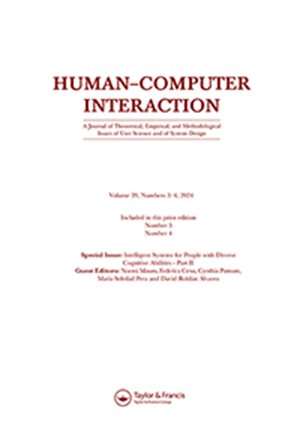超越人类设计的美学:Chthulucene的投机能量简报
IF 4.4
2区 工程技术
Q1 COMPUTER SCIENCE, CYBERNETICS
引用次数: 0
摘要
这篇论文是对人机交互设计的理论贡献,它将超越人类(MTH)视为人机交互设计的内在部分。它特别关注MTH作为应对气候危机的核心,这体现在能源需求减少和智能电表上。这是通过扩展“设计事件”的概念来探索的,从美学上定义为展开和成为异质人类和非人类元素的模式或构象。有了这个版本的设计事件,MTH可以更直接、更有效地参与进来。我们这样做是参考环境问题,正如哈拉威的投机未来“Chthulucene”所暗示的那样——一个适合居住的未来世界。本文将HCI中的设计简报,以及更广泛的设计,视为探索和确定发明的美学可能途径的问题,这必然涉及MTH元素。本文提出了三个相互关联的设计概要,提出了实践者如何着手解决能源需求减少和计量问题,并提供了一套关于如何设计和编写超越人类的推测性概要的指导方针。这篇论文认为,这涉及到对投机性的MTH成分变得敏感,在这些成分中,新形式的“意义构建”将替代可能性(愚蠢的)与能量的关系定向。本文章由计算机程序翻译,如有差异,请以英文原文为准。
The aesthetics of more-than-human design: speculative energy briefs for the Chthulucene
This paper is a theoretical contribution to HCI that considers the more-than-human (MTH) as an intrinsic part of human–computer interaction design. In particular, it focuses on MTH as central to responses to the climate crisis as manifested in energy-demand reduction and smart meters. This is explored by expanding on the notion of the ‘design event’, defined aesthetically as the patterns or conformation of unfolding and becoming of heterogenous human and non-human elements. It is with this version of the design event that the MTH can be more directly and effectively engaged. We do this with reference to environmental problems as signaled by Haraway’s speculative future ‘the Chthulucene’ – a worlding for liveable futures. The paper views design briefs in HCI, and design more broadly, as problematics for exploring and determining aesthetic-possible pathways for invention, which necessarily involves MTH elements. Three interrelated design briefs are presented that propose how practitioners might go about addressing energy-demand reduction and metering and provide a set of guidelines on how to devise and write speculative more-than-human briefs. This, the paper argues, involves becoming sensitive to speculative MTH compositions where novel forms of ‘sense making’ orient alternative possibilistic – idiotic – relations to energy.
求助全文
通过发布文献求助,成功后即可免费获取论文全文。
去求助
来源期刊

Human-Computer Interaction
工程技术-计算机:控制论
CiteScore
12.20
自引率
3.80%
发文量
15
审稿时长
>12 weeks
期刊介绍:
Human-Computer Interaction (HCI) is a multidisciplinary journal defining and reporting
on fundamental research in human-computer interaction. The goal of HCI is to be a journal
of the highest quality that combines the best research and design work to extend our
understanding of human-computer interaction. The target audience is the research
community with an interest in both the scientific implications and practical relevance of
how interactive computer systems should be designed and how they are actually used. HCI is
concerned with the theoretical, empirical, and methodological issues of interaction science
and system design as it affects the user.
 求助内容:
求助内容: 应助结果提醒方式:
应助结果提醒方式:


